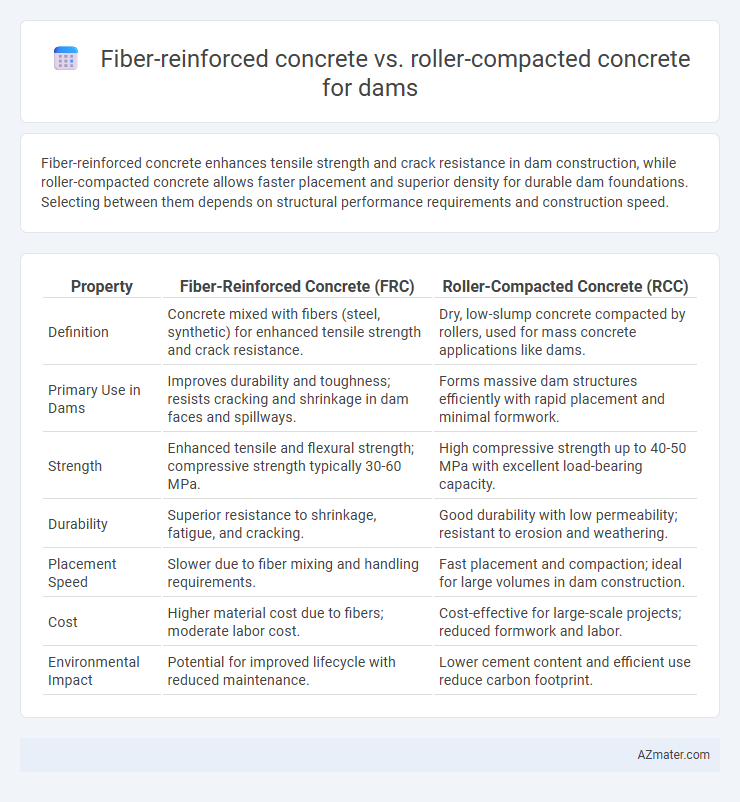Fiber-reinforced concrete enhances tensile strength and crack resistance in dam construction, while roller-compacted concrete allows faster placement and superior density for durable dam foundations. Selecting between them depends on structural performance requirements and construction speed.
Table of Comparison
| Property | Fiber-Reinforced Concrete (FRC) | Roller-Compacted Concrete (RCC) |
|---|---|---|
| Definition | Concrete mixed with fibers (steel, synthetic) for enhanced tensile strength and crack resistance. | Dry, low-slump concrete compacted by rollers, used for mass concrete applications like dams. |
| Primary Use in Dams | Improves durability and toughness; resists cracking and shrinkage in dam faces and spillways. | Forms massive dam structures efficiently with rapid placement and minimal formwork. |
| Strength | Enhanced tensile and flexural strength; compressive strength typically 30-60 MPa. | High compressive strength up to 40-50 MPa with excellent load-bearing capacity. |
| Durability | Superior resistance to shrinkage, fatigue, and cracking. | Good durability with low permeability; resistant to erosion and weathering. |
| Placement Speed | Slower due to fiber mixing and handling requirements. | Fast placement and compaction; ideal for large volumes in dam construction. |
| Cost | Higher material cost due to fibers; moderate labor cost. | Cost-effective for large-scale projects; reduced formwork and labor. |
| Environmental Impact | Potential for improved lifecycle with reduced maintenance. | Lower cement content and efficient use reduce carbon footprint. |
Introduction to Modern Dam Construction Techniques
Fiber-reinforced concrete enhances dam construction by significantly improving tensile strength and crack resistance, making it ideal for complex structural demands and increased durability. Roller-compacted concrete offers rapid placement and cost-efficiency through its zero-slump consistency and compacted layering, streamlining the construction process for large dam projects. Modern dam construction integrates these advanced concrete technologies to optimize structural performance, reduce construction time, and extend service life under varying environmental stresses.
Overview of Fiber-Reinforced Concrete (FRC)
Fiber-Reinforced Concrete (FRC) incorporates synthetic or steel fibers to enhance ductility, tensile strength, and crack resistance, making it ideal for dam structures requiring durability under dynamic loads. The dispersed fibers improve impact resistance and reduce shrinkage cracking, contributing to long-term structural stability in hydraulic applications. Its permeability control and toughness make FRC a preferred choice for zones in dams subjected to hydraulic pressure and mechanical stress.
Fundamentals of Roller-Compacted Concrete (RCC)
Roller-Compacted Concrete (RCC) is a dry-mix concrete placed with earthmoving equipment and compacted by vibratory rollers, offering high strength and durability essential for dam construction. Its low water content reduces shrinkage and permeability, enhancing resistance to cracking and increasing overall stability compared to fiber-reinforced concrete. RCC's rapid placement and cost efficiency make it a preferred choice for large-scale dam projects requiring robust structural integrity and fast construction timelines.
Structural Performance Comparison: FRC vs RCC
Fiber-reinforced concrete (FRC) offers enhanced tensile strength and crack resistance compared to roller-compacted concrete (RCC), improving durability under dynamic load conditions typical in dam structures. RCC provides superior compressive strength and rapid placement efficiency, making it ideal for large-scale dam construction but may require additional reinforcement in tension-critical zones. The choice between FRC and RCC depends on balancing the need for toughness and crack control with construction speed and structural load requirements in dam engineering.
Durability and Longevity Analysis
Fiber-reinforced concrete enhances durability in dam structures by providing superior crack resistance and improved tensile strength, reducing maintenance costs over time. Roller-compacted concrete offers excellent longevity through its compacted, low-porosity matrix, which resists erosion and weathering in harsh hydraulic environments. Comparative studies show that fiber-reinforced concrete maintains structural integrity under dynamic loads, while roller-compacted concrete excels in large-scale dam construction with faster placement and consistent durability performance.
Crack Resistance and Maintenance Requirements
Fiber-reinforced concrete (FRC) offers superior crack resistance in dam construction due to its enhanced tensile strength and ability to control micro-cracks, reducing the likelihood of structural deterioration. Roller-compacted concrete (RCC) provides a dense, low-porosity matrix that requires minimal maintenance but may need additional measures to address thermal cracking risks. In maintenance, FRC demands less frequent repairs related to crack propagation, whereas RCC benefits from straightforward upkeep processes tied to its robust compaction and reduced permeability.
Construction Speed and Cost Efficiency
Fiber-reinforced concrete enhances durability with minimal increase in material costs but generally requires longer curing times, impacting construction speed for dam projects. Roller-compacted concrete offers faster placement and compaction, reducing construction time significantly and lowering labor costs, making it highly cost-efficient for large-scale dam construction. The choice between the two depends on prioritizing rapid construction and budget savings with roller-compacted concrete or improved structural toughness with fiber-reinforced concrete.
Environmental Impact and Sustainability
Fiber-reinforced concrete (FRC) enhances durability and reduces crack propagation, leading to longer dam lifespans and less frequent repairs, thereby minimizing resource consumption and environmental disruption. Roller-compacted concrete (RCC) offers lower cement content and energy-efficient placement methods, reducing carbon emissions and water usage during dam construction. The sustainability of dam projects improves with RCC's rapid construction and FRC's durability, balancing environmental impact through optimized material performance and reduced maintenance demands.
Case Studies: Dams Using FRC and RCC
Fiber-reinforced concrete (FRC) has been successfully implemented in dam projects like the Upper Stillwater Dam in the United States, enhancing tensile strength and crack resistance in key structural zones. Roller-compacted concrete (RCC) is prominently used in large-scale dam constructions such as the Shuibuya Dam in China, where rapid placement and cost efficiency are prioritized. Case studies show FRC offers improved durability in seismic areas, while RCC excels in massive, rapid-fill dam projects requiring high production rates.
Choosing the Optimal Concrete for Dam Projects
Fiber-reinforced concrete enhances tensile strength and crack resistance, making it ideal for dam structures requiring durability under dynamic loads and thermal stresses. Roller-compacted concrete offers rapid construction benefits with excellent compressive strength and low permeability, suited for large-scale dam foundations and embankments. Selecting between fiber-reinforced and roller-compacted concrete depends on project-specific demands such as load conditions, construction timeline, and environmental exposure.

Infographic: Fiber-reinforced concrete vs Roller-compacted concrete for Dam
 azmater.com
azmater.com